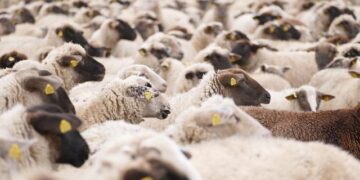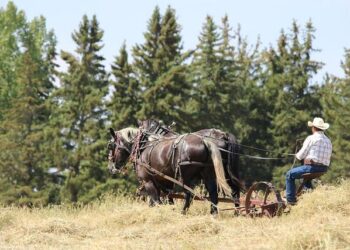Stories about wolves—some true, many not—have enlivened folktales for thousands of years, whether it’s the Big Bad Wolf in Little Red Riding Hood or legends of werewolves hunting under the full moon.
While the variations change over time—few modern children’s books warn of wolves eating grandmothers—the stories inevitably paint the world’s largest canine with a polarized brush.
How people view gray wolves still generates plenty of debate, particularly when animals are killed. In February in western Wyoming, a man named Cody Roberts ran over a young male wolf with his snowmobile, taped its mouth shut, and paraded it around a local bar before shooting the animal out back, according to state and county officials.
While Wyoming, which is home to more than 350 wolves as part of the Greater Yellowstone Ecosystem, is not known as a wolf-loving state, that act was so horrific even the state’s hunting community has rallied in opposition. Photos of incident, which went viral in April, have caused an international outcry. (Read more about the conservation history of wolves in the U.S.)
“One person went out and did something that to almost everybody is unconscionable,” says Brian Nesvik, director of the Wyoming Game and Fish Department. “I’ve heard from hundreds of people, and I haven’t talked to one person yet who says that’s acceptable.”
In many cases, the deep-rooted mythology of wolves as villains can lead to broader misunderstandings. National Geographic asked Nesvik and other wolf researchers to dispel some of the most common wolf myths.

A wolf scares ravens off its food in Yellowstone National Park. The park is home to at least 120 wolves.
Photograph By BARRETT HEDGES, National Geographic Image Collection
Myth 1: Wolves kill for fun
While no wolf researcher claims to understand the feelings of an individual wild animal, the idea that wolves kill for fun—often referred to as surplus killing—isn’t based on reality.
Wolves live on the fringe of nutritional deficiency, not starving, but also not layering on fat, according to Ken Mills, the Wyoming Game and Fish Department’s wolf biologist.
“They’re lean marathoners. They have to cover a lot of ground to find vulnerable prey and then catch it with their mouths, … pull it down, and kill it. That is not easy,” Mills says.
What’s more, hunting large prey such elk and moose is just plain dangerous. In Yellowstone, where humans cannot hunt wolves, injuries sustained during big game hunts are the second leading cause of death for the carnivores, says Kira Cassidy, a researcher with the Yellowstone Wolf Project, one of the longest, most detailed wolf studies in the world.
“Wolf packs are only successful in a small percentage, generally 10 to 20 percent, of their attempted hunts,” Cassidy says. (See 12 of our favorite wolf photos.)
And because finding food is no guarantee, if there’s attainable prey in front of them, they will kill it, she says.
Unless the wolves are run off by people or another wolf pack, they will keep returning over and over to dine on a carcass until it’s gone.
In Mills’ 23 years working with wolves in Wyoming, Michigan, Ontario, and New Mexico, he has only investigated a couple of incidents of wolves killing more animals than they could eat, including the well-publicized incident of a wolf pack killing 19 elk in Wyoming.

Wolves pick at the remains of a muskox. To get this image, photographer Ronan Donovan placed a camera trap inside the carcass. The pack returned to feed on and off for a month.
Photograph By RONAN DONOVAN, National Geographic Image Collection
Myth 2: Wolves are ecosystem saviors
The concept of trophic cascade has persisted since scientists reintroduced wolves into Yellowstone National Park in the 1990s. The basic idea is that when wolves no longer inhabit a landscape, ungulates such as deer, elk, and moose become abundant and damage meadows, mountainsides, and wetland areas.
Yet recent research shows the story just isn’t so simple.
Ecosystems like Yellowstone changed so fundamentally after the removal of wolves (and grizzly bears) that, at least in some places, it could not return to its before state just by bringing these predators back, according to research published earlier this year in the journal Ecological Monographs.
The work, based on 20 years of research in Yellowstone, found that the landscape is in “an alternative stable state,” and has not returned to its previous one.
“Wolves are an important component of a healthy ecosystem,” Cassidy says, “but their presence is not the only critical factor in the health, stability, or resilience of an area.”
Myth 3: Wolves attack people
Children’s movies like Frozen and Beauty and the Beast suggests wolves are a danger to people. In truth, a wolf attacking a person is exceedingly rare—two people have died in encounters with wolves in North America in the past century. (The Walt Disney Company is majority owner of National Geographic Media.) Lightning, by contrast, kills about 28 Americans per year.
Gray wolves live across the northern portion of the globe, from the U.S. and Canada through Europe and Asia, and run-ins with people are equally rare in these environments.
“My experience is they’re pretty terrified of people,” Cassidy says. “Or they are very wary to the point where most people won’t see one.”
Myth 4: Given the chance, wolves will decimate wild herds
Gray wolves in North America and their prey, largely big ungulates like deer, elk, moose, and bison, have co-evolved for tens of thousands of years. As wolves improve at hunting, elk become better at defending and escaping. (Explore the Yellowstone most don’t see.)
“This fascinating interconnected evolution is the reason prey species such as elk are large, fast, and intelligent,” Cassidy says. “Any of the individual elk that were not were more likely to be killed and therefore were less likely to pass on their genes.”

Nicknamed “sea wolves,” these canines live on British Columbia’s rugged coast, feeding on fish and other marine life.
Photograph By IAN MCALLISTER, National Geographic image collection
The same applies to gray wolves, as the two species compete in an evolutionary arms race that provides one creature a slight edge before the other one catches up.
In areas where prey species decline—often because of disease and human development—wolves either raise fewer pups, lose more pups, or branch out and look for new food sources.
No matter what people think of wolves, they’re simply another species on the landscape, Nesvik says—one trying to fill its belly just like the rest of us.
>>> Read full article>>>
Copyright for syndicated content belongs to the linked Source : National Geographic – https://www.nationalgeographic.com/animals/article/myths-gray-wolves-north-america-predators































